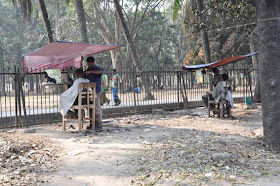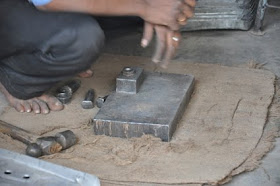
 Whilst moving around Dhaka I have been struck by the amount of commerce taking place and the way in which people buy and sell, the nature of business and the scale of the workshops particularly their relationship with the street, the way they occupy or extend out into the traffic.
Whilst moving around Dhaka I have been struck by the amount of commerce taking place and the way in which people buy and sell, the nature of business and the scale of the workshops particularly their relationship with the street, the way they occupy or extend out into the traffic.

I think its visually interesting to see how and where people work, and sell.



 Some stalls are portable, anything that could be easily packed and carried.
Some stalls are portable, anything that could be easily packed and carried. Adapted cycles, although you wouldn't want too much stock or you might crash!
Adapted cycles, although you wouldn't want too much stock or you might crash!













 The street as display and selling place also becomes an extension of the workshop. This may be partly due to necessity, as the buildings are so small, its interesting to see how inventive the workers are with limited facilities, space and equipment. I also wondered what happened during monsoon.
The street as display and selling place also becomes an extension of the workshop. This may be partly due to necessity, as the buildings are so small, its interesting to see how inventive the workers are with limited facilities, space and equipment. I also wondered what happened during monsoon.


Sometimes an individuals business was literally in their hands as they walked around the city.



 Some stalls are portable, anything that could be easily packed and carried.
Some stalls are portable, anything that could be easily packed and carried. Adapted cycles, although you wouldn't want too much stock or you might crash!
Adapted cycles, although you wouldn't want too much stock or you might crash!

some 'shops' are defined by a landmark, a tree or the corner of two roads, some are as a small as a mat or a basket or as long as the pavement stays clean and even.





Sometimes the displays are beautiful in their arrangement, colours, inventiveness and the props which go to announce the services or goods for sale.






The produce and goods are constantly re positioned and carefully arrange to show them off to their best or services.

 The street as display and selling place also becomes an extension of the workshop. This may be partly due to necessity, as the buildings are so small, its interesting to see how inventive the workers are with limited facilities, space and equipment. I also wondered what happened during monsoon.
The street as display and selling place also becomes an extension of the workshop. This may be partly due to necessity, as the buildings are so small, its interesting to see how inventive the workers are with limited facilities, space and equipment. I also wondered what happened during monsoon.
The city seems divided into focused areas. Parts of the city deal with metal working others jewellery, stonework, recycling, ceramics, timber, printing, bicycles, wedding outfits, textiles, vegetables, fish.....etc. Their is a sense that Dhaka is one giant market with regional focuses. The areas may have developed historically due to the geographical or social factors - ports, families passing skills down over generations whilst continuing to live in the same area, etc.
Specialist trades e.g polishers, platers, stone setters .... have set up close by, in support of each other, die makers for the jewellers, ceramicists for crucibles, all working together making components/ providing services for each other.
I have been struck by how specialised many of the businesses are, e.g. men working for companies just making the claw settings for rings, workshops who's sole job is to punch holes into the metal sub frames for motorcycle seats which are subsequently transported across the road to a company which glues the foam padding to the metal, which then goes to another to be covered. The shifts seem very small. As designers and makers in the UK many of us use and cover a much broader range of skills and have greater input in the production of a product, often only bringing in very specialist sub contractors due to high cost or niche skills.










